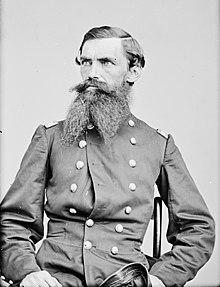3rd West Virginia Cavalry Regiment
| 3rd West Virginia Cavalry Regiment | |
|---|---|
 Flag of West Virginia | |
| Active | December 1861 to June 23, 1865 |
| Country | United States |
| Allegiance | Union |
| Branch | Cavalry |
| Engagements | American Civil War 1862: Cross Keys, Second Bull Run |
| Commanders | |
| Lt. Colonel | David H. Strother 1862–1864 |
| Colonel | John L. McGee 1864–65 |

The 3rd West Virginia Cavalry Regiment was a cavalry regiment that served in the Union Army during the American Civil War. In 1864, the regiment had an important part in the Battle of Moorefield, where a surprise attack led by General William W. Averell routed Confederate cavalry. The regiment also fought in the latter part of General Philip H. Sheridan's Valley Campaign, and was part of Capehart's Fighting Brigade in General George Armstrong Custer's Third Division. It was present at General Robert E. Lee's surrender of the Army of Northern Virginia at the Battle of Appomattox Court House.
Organization
The 3rd West Virginia Cavalry Regiment was organized in western Virginia in December, 1861, with the first company of the regiment organized and recruited in Morgantown. It was the first cavalry regiment raised by West Virginia under the Union government in Wheeling. David H. Strother was the regiment's original commander. He began as lieutenant colonel and later was promoted to colonel. However, he never commanded the regiment in the field. Instead, he spent time on the staffs of generals Nathaniel Banks, John Pope, George McClellan, Benjamin F. Kelley, David Hunter, and Franz Sigel. He resigned from the army after Hunter was replaced by Philip Sheridan.[1] Field commanders were often Major Seymour B. Conger and Colonel John L. McGee.
Early action
Under Captain J.L. McGee, the regiment first reported to General B.F. Kelley at Grafton, where it was ordered to New Creek (Keyser), then on to take part in General Kelley's advance on Romney, where it charged Confederate breastworks. This charge was delivered with fine spirit and most satisfactory results, with the whole of the enemy's artillery, stores and flags being taken without casualties.
This advance was soon followed by the surprise of the Rebels at Blues Gap; resulting in the capture of a number of rebel prisoners, three pieces of artillery and the entire camp's supplies and munitions, driving them to the eastern slope of the Alleghenies and transferring the field of active operations to the Valley of Virginia. Captain McGee was promoted to Major of the 3rd West Virginia Cavalry on October 2, 1861.
In 1862, Company C, under Captain Conger, frequently engaged Confederate troops while in pursuit of “Stonewall” Jackson during his retreat up the Shenandoah Valley.
Everton Conger left the 3rd West Virginia Cavalry during September 1863 to join the 1st District of Columbia Cavalry Regiment as a major. After the assassination of President Abraham Lincoln, Everton Conger and the 16th New York Cavalry Regiment were involved with the capture of assassin John Wilkes Booth.[2]
War's end
On April 2, 1864 at Ford's Station, under Lieutenant-Colonel John S. Witcher, the 3rd Cavalry charged and drove back a brigade of rebel cavalry, killing Confederate General Pegram. The regiment continued its duty, participating in the engagements at Appomattox Station and Court House, consequently present during Robert E. Lee's surrender on April 9.
The regiment participated in the Grand Review of the Armies and was mustered out on June 23, 1865.
Casualties
The 3rd West Virginia Cavalry suffered 6 officers and 40 enlisted men killed or mortally wounded in battle and 136 enlisted men dead from disease for a total of 182 fatalities.[3]
Commanders
See also
Notes
Footnotes
Citations
- ^ Strother & Elby 1998, p. xx
- ^ Wolfe 2021, pp. 43–47
- ^ "Union - West Virginia Cavalry". www.civilwararchive.com. Retrieved December 15, 2024.
References
- Lang, Theodore F. (1895). Loyal West Virginia from 1861 to 1865: With an Introductory Chapter on the Status of Virginia for Thirty Years Prior to the War. Deutsch publishing Company. pp. 197–.
 This article incorporates text from this source, which is in the public domain.
This article incorporates text from this source, which is in the public domain. - Strother, David Hunter; Elby, Cecil D. (1998). A Virginia Yankee in the Civil War: the Diaries of David Hunter Strother. Chapel Hill, North Carolina: University of North Carolina Press. ISBN 978-0-80786-666-5. OCLC 45843936.
- Wolfe, Richard A. (2021). "Tracking Booth: Everton Conger went Down in History for his Role in Capturing John Wilkes Booth. Here's the Story of How He got There". Military Images. 2 (216). Arlington, Virginia: University of North Carolina Press: 43–47. ISBN 978-0-80786-666-5. JSTOR 26988442. OCLC 45843936. Retrieved 2022-02-01.
External links
- Sgt of Co D 3rd W V Cavalry
- Petruzzi's history
- History from Military Images
- Battles - National Park Service
- 3rd West Virginia Cavalry archives - West Virginia State Archives
